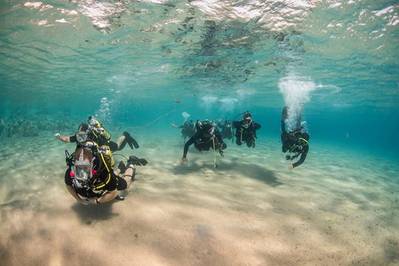Sonardyne's IDS Teseted in Naval Exercises
Diver detection sonar technology developed by Sonardyne International Ltd, UK, has played a part in a international exercise organized to train naval forces in mine countermeasures, maritime security operations and harbor protection operations.
The International Mine Counter-Measures Exercise (IMCMEX) runs off the coast of Bahrain every 18 months to test the abilities of the navies of the world to keep sea lanes open and safe. A total of 6,500 personnel and 38 warships from 44 navies took part in the event, the third and largest so far.
Sonardyne’s Sentinel Intruder Detection Sonar (IDS) is a sonar that has been developed to detect divers and small underwater targets, thereby providing local underwater situational awareness. The sonar is deployed to protect military ports, harbors and vessels, in addition to shore side critical national infrastructure, commercial ports and vessels. It reliably detects, tracks and classifies targets including surface swimmers, divers and underwater vehicles approaching a protected asset up to 1 kilometer away from any direction.
Over the course of the three week long exercises, the U.S. Navy owned and operated expeditionary Sentinel system was deployed in a variety of scenarios to demonstrate its capabilities as a rapidly deployable technology for protecting high value marine assets. Divers from participating countries were challenged to evade detection during simulated assaults on various naval assets protected by Sentinel. On each occasion, Sentinel was successful in alerting operators to the approaching threat.
For this year’s IMCMEX, organizers broadened the focus of the exercise to include maritime security operations such as escorting and defending commercial shipping, and maritime infrastructure protection for oil rigs and harbors. “With a quarter of the world's navies in attendance, this was the perfect environment to demonstrate Sentinel’s capabilities in protecting high value offshore facilities, ports and critical waterside infrastructure,” commented Nick Swift, Sonardyne’s Business Manager for Maritime Security.
From as early as 2008, Sentinel has been used by the U.S. Navy as part of its Integrated Swimmer Defense program. It was selected following rigorous trials where it was shown to meet their stringent performance requirements for diver detection.
Quick and easy to mobilize, the small design of Sentinel’s sonar head enables a variety of deployment options including lightweight frames for short term deployment, seabed towers, wall, pile or rail mounts for shore side facilities and through hull or over the side deployment for installation on vessels.
A major benefit of Sentinel is that once deployed, the system requires minimal user intervention. Its autonomous operation means that it can be left unattended to seek out and detect intruders.













